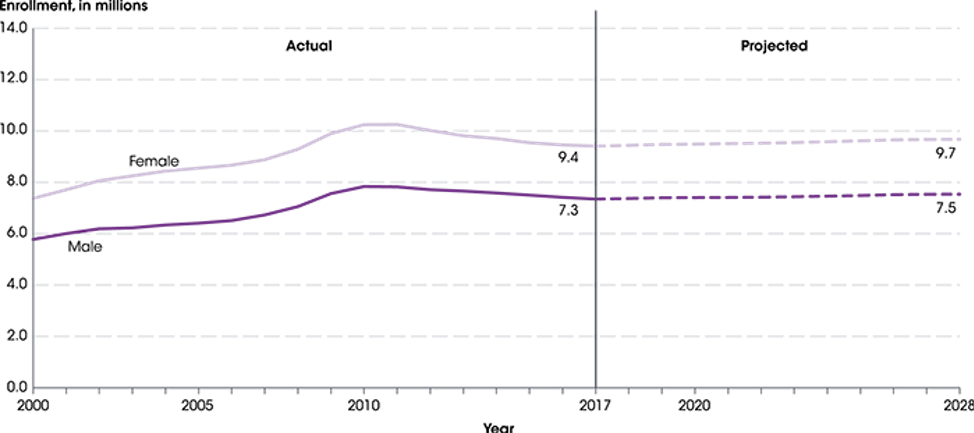The Demographic Challenge of Higher Education
By Dr. Watson Scott Swail
Most postsecondary institutions across the country are experiencing sharp and steady declines in enrollment. This is for two primary reasons: demographic and economic trends. In 2010, the US hit a peak of college-aged students that has since been on a slow decline. The chart below illustrates both the decline and the projected enrollment until 2028. The data, from the National Center for Education Statistics (NCES), suggests that there will be a very subtle increase in enrollment over the next 10 years, albeit not likely to make a major impact on the enrollment at any particular institution.

SOURCE: https://nces.ed.gov/programs/coe/indicator_cha.asp
But while the analysis at NCES suggests that enrollments may be levelling, I beg to differ. Demography and population studies are a very complex business, and my analysis is expectedly simple. This morning I pulled the latest US population trend data from the US Census Bureau, representing singular age categories between 2010 and 2018. The chart below illustrates the net change for each population group between ages zero (birth) and 30. The 2018 college-aged population (18-19) dropped 4 and 7 percent, respectively, over the prior eight years, having a considerable impact on the potential pool of college-eligible (not necessary college ready or college inclined) youth. The chart also illustrates the increase in the post-college population. For instance, the 26-year old population rose 14 percent during the same period.
Most importantly, the chart outlines future potential enrollment by illustrating the net changes. Although the data suggest a very slight spike of two percent for 11-year olds, the age groups between zero and six are all in the negative, if only slightly. This will, over time, turn into our college-aged population which will similarly present a negative trend.

I did mention that the economy was also a lever for enrollment declines. As is fairly well documented and understood by higher education analysts and administrators, a strong economy leads to a decline in people who enroll in college. When jobs are readily available, people choose to work and either put off their postsecondary studies or never enter or return. This is the strongest economy in US history and we aren’t sure if we have hit the zenith quite yet. Regardless, it will remain strong for the next few years, having a continued impact moreso on two-year compared to four-year institutions.
If enrollment declines are to reverse in the foreseeable future, there are four things that need to happen. Given that there is no expectation that there will be a large increase in the number of births, we can’t count on demographics to fix the issue. Thus, the first strategy would be to increase the pool of college ready and college inclined youth who matriculate from high school to college. The challenge here is that we have, to some degree, maximized the college-going population, especially at the four-year level. The argument that we push more students and families to bachelor’s degrees and beyond with resulting debt loads is problematic, practically and ethically. The truth is, even in this surging economy, there is no guarantee of jobs commensurate with an earned degree. Too many BA grads are working below-skill-level jobs. As well, pushing billions of additional student debt onto students will have a horrific result in eating away any possibility of retirement for this and future generations. The more likely practical enrollment push would be at the less-than and two-year levels to produce workforce talent in trades and related areas.
The second thing we could do is market for a large increase in international student enrollment at the undergraduate level. However, according to the Institute for International Education (IIE), a major reason for the decreasing international enrollment is current political uncertainty in the United States.[1] Students that used to come to the US are now going to Canada, China, and Australia.[2] This issue is one or two election cycles away and we will wait to see if there are long-term implications of recent political issues.
Third would be to increase the retention of students who enter and complete a college certificate, diploma, or degree. This doesn’t deal with the demographic issues identified, but it does fill seats that are going empty because of relatively poor retention rates in US institutions of higher education. Increasing retention means more tuition, fees, and subsidies.
And fourth, if the economy goes in the tank, enrollment will improve. Obviously, this isn’t a prudent policy focus.
My view is that the greatest challenge of higher education is less about demography and more about our insatiable appetite for more. More students means more professors and more administrators and more alumni contributions. The system has been perpetuated on “more.” At some point, there is a declining return on investment to our higher education system, and, given the cost increases over the past 50 years, we are now reaching the point where we can argue whether a college degree is worth it. As well, one of the reasons we can still make that argument is the watering down of jobs such that college graduates are taking jobs once owned by high school graduates, even though the day-to-day skills are no different.
Our system is built on a model of escalating enrollment. The dream of more and bigger for board trustees and administrations has hit a wall, similar to what we are seeing with Social Security. When the population grays and the young, who are expected to take up the gauntlet for the rest of us, begins to decline, we face uncertainty about our collective fiscal sustainability. And this is what we are seeing in postsecondary education for all sectors. Declines are everywhere.
Higher education isn’t going anywhere and nor should it. It has a major positive impact on both society and the individual. It is important to our democracy and to our philosophy of who we are as a nation. But institutions, especially small institutions, need to be very mindful of their focus and mission. These demographic trends, as well as increased competition for a fairly finite group of college-inclined students, strongly suggests that many colleges will shutter in the next decade. This is not necessarily a bad thing because we can easily argue that 4,000 two- and four-year public and non-profit institutions is too much of a good thing. In fact, I argue that it isn’t a good thing. The massification caused by the Morrill Acts, the GI Bill, the Pell Grant, and other levers of growth have led us to a place where we have a built a system too large for our needs. Still, the marketing for more continues because each of these “businesses” are trying to eke out an existence.
At EPI, we can say from experience that we are seeing institutions scattering to find answers to the enrollment and related revenue declines. We work with colleges on enrollment management, strategic planning, and student retention and success and are currently seeing many more colleges reaching out for help to increase their enrollment in the face of numbers such as presented herein. They are all looking for magic in the enrollment market game. The reality is that those who figure out a way to climb out of this mess are those that focus on their niche market and those that are simply stronger than anyone else. At greatest risk are the small private and the two-year publics who are being hit hard by the strong economy. This will change, but whether it changes enough to make an appreciable difference remains to be seen.
[1] https://www.nafsa.org/sites/default/files/media/document/nafsa-losing-talent.pdf
[2] https://www.reuters.com/article/us-usa-immigration-students/fewer-foreign-students-coming-to-united-states-for-second-year-in-row-survey-idUSKCN1NI0EN.

